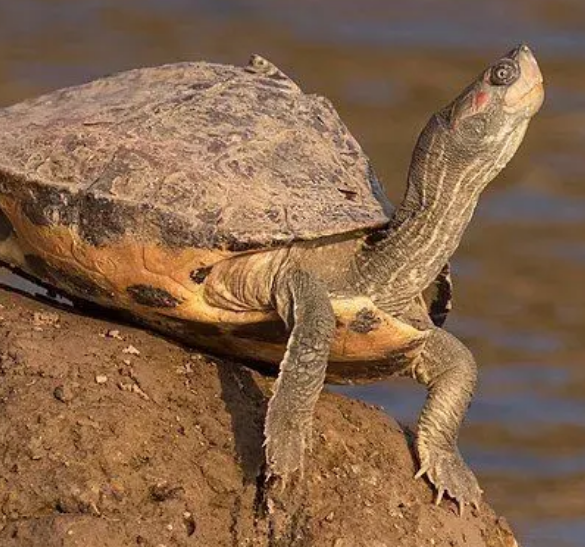Description

Copyright infringement is not intended
Context: Indian tent turtle is listed in Schedule –I of the Wild Life (Protection) Act, 1972 and is thereby provided the highest degree of protection.
- The Zoological Survey has not conducted any survey in the Narmada River on impact of illegal mining on Indian tent turtle and its effect on river ecosystem.
About Indian tent turtle:
- It is a species of turtle that is native to India, Nepal and Bangladesh and it is quite similar to the Indian roofed turtle.
- The Conservation Status:
- IUCN: Lower Risk/ least concern
- IWPA: Schedule I
- CITES: Appendix II
- Characteristics, Habitat and Behaviour:
- It has an olive or brownish head with a red postocular spot.
- The males are smaller than the females in size and have longer and thicker tails. The tentoria subspecies have a moderately small and pointed head that is shorter than the orbit. Their carapace is oval and elevated with a distinct vertebral keel that is spiked and the plastron is truncated anteriorly and notched posteriorly.
- Its habitats include still water pools on river side and slow running water near the river banks. These are active swimmers and are mainly herbivorous.
- Major Threats:
- Due to the attractive appearance of the species, they are illegally traded in the pet market
- Distribution:
- Three subspecies recorded from India viz., P. t. tentoria, P. t. circumdata and P. t. flaviventer.
- t. tentoria occurs in peninsular India and is recorded from Orissa, Maharashtra, Andhra Pradesh, Assam and Madhya Pradesh.
- t. circumdata occurs in the western tributaries of Ganga and the rivers of Gujarat. It is found in Rajasthan, Madhya Pradesh, Uttar Pradesh and Gujarat.
- t. flaviventer occurs in the northern tributaries of Ganga and is recorded from Uttar Pradesh, Bihar, West Bengal and Assam.
The Government has taken several steps to protect the Indian tent turtle species:
- Protected Areas, viz., National Parks, Wildlife Sanctuaries, Conservation Reserves and Community Reserves have been created in the country covering important habitats to provide better protection
- Financial assistance is provided to the State/Union Territory Governments under the Centrally Sponsored Scheme of ‘Integrated Development of Wildlife Habitats’, for providing better protection to wildlife and improvement of habitat.
- The Wild Life (Protection) Act, 1972 provides for stringent punishment for violation of its provisions.
- The local communities are involved in conservation measures through eco-development activities which help the forest departments in protection of wildlife.
- The Wildlife Crime Control Bureau (WCCB) coordinates with State/UTs and other enforcement agencies to gather intelligence about poaching and unlawful trade in wild animals and animal articles.
https://pib.gov.in/PressReleaseIframePage.aspx?PRID=1814557#:~:text=Indian%20tent%20turtle%20is%20listed,illegal%20mining%20in%20Narmada%20River














